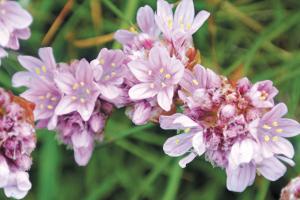In New Orleans I often heard of people stashing a bit of money or "a little somethin' somethin'." Likewise, a tiny bit of cash is often called "pin money," referring to a woman's small allowance to literally buy sewing needs. All in the name of thrift.
The garden sometimes needs a little reserve or a plant that just creeps along, not flashy, but in a thrifty way. So we have Sea Pinks, known as Thrift (Armeria maritima).
These low-growing perennials are often found growing quietly along coastal cliffs, salt marshes and wild areas.
They eventually grow up to 12 inches high with rough, narrow, dark-green leaves that look like tall grass. The clumping plants form stalks topped with round pin cushions of pink, red or white flowers. These evergreen plants are resistant to deer damage so are great for wild areas.
Though they bloom from late spring through early summer, Sea Pinks often sport flushes of blossoms throughout the summer, a little "somethin' somethin'" for the garden.
These are about the easiest perennials to grow. Because they come from rough areas, they literally thrive on neglect.
In fact, poor soil is actually better for them than rich soil, which may cause them to grow lots of greenery but few flowers. They are super hardy, able to survive all the way up to USDA zone 3.
The only real important thing is for Sea Pinks to have soil that drains well. Standing water or wet soil will rot them at the roots.
Sturdy plants that they are, they stand up to strong winds, drought and even salt air, so they make ideal flowers for seaside gardens. They even grow in soils with heavy metals such as mercury or lead.
Plant Sea Pinks in full sun. For best results, soak the seeds in warm water for about eight hours before planting them. There are a few popular colors in addition to the traditional pink.
Try Alba, with creamy white flowers; the bright red Dusseldorf Pride that blooms right up until fall; and Rubrifolia, whose dark-crimson flowers are set off by nearly black leaves.
You can sow Sea Pink seeds directly in the garden from late spring through the summer months right up to about two months before your first fall frost.
You can also start seeds indoors and transplant them anytime. They will often bloom the first year planted. To encourage reblooming, cut off the dead blossoms.
Water newly planted seeds regularly, but do not leave them in standing water or soggy soil. After they are established, Sea Pinks rarely need additional watering.
If by chance your plants rot at the center, just cut them back to the ground and water until they revive. You can increase your plantings by dividing mature clumps and immediately replanting them.
So plant Sea Pinks or Thrift in your garden, and enjoy these carefree perennials and their year-round green leaves with colorful pom-pom flowers. It will not be the big splash of major plantings but just a little somethin’ somethin.’























































